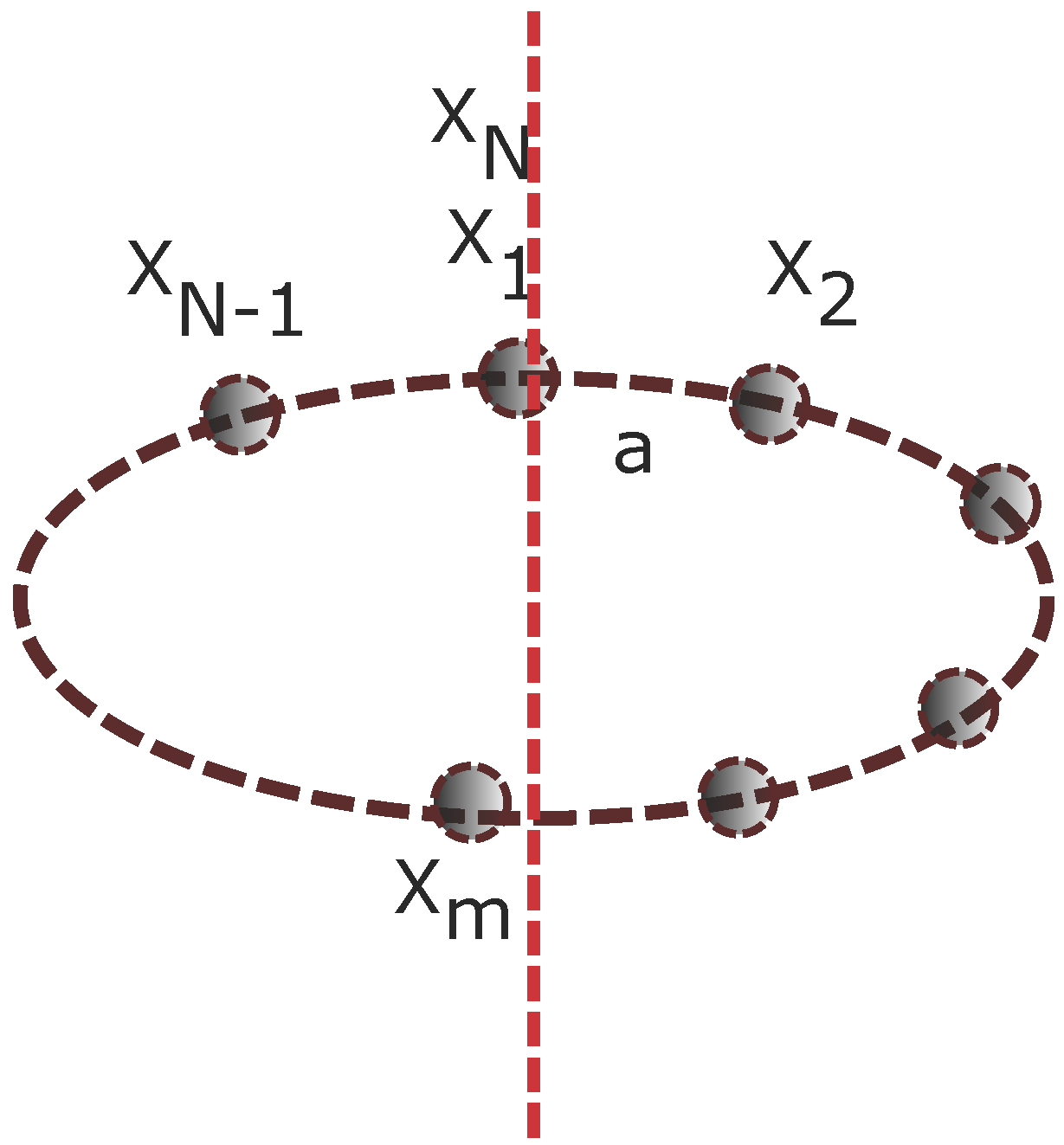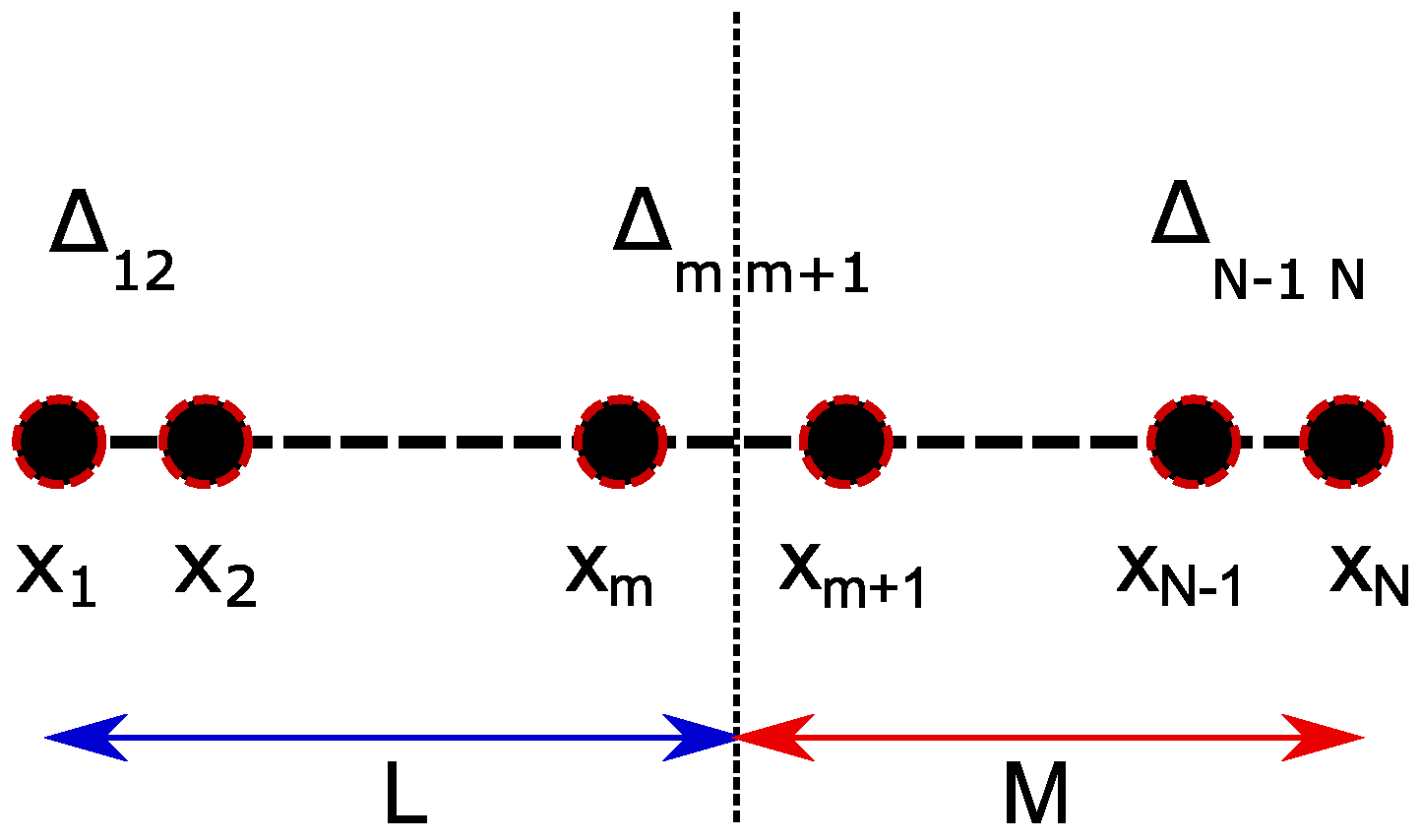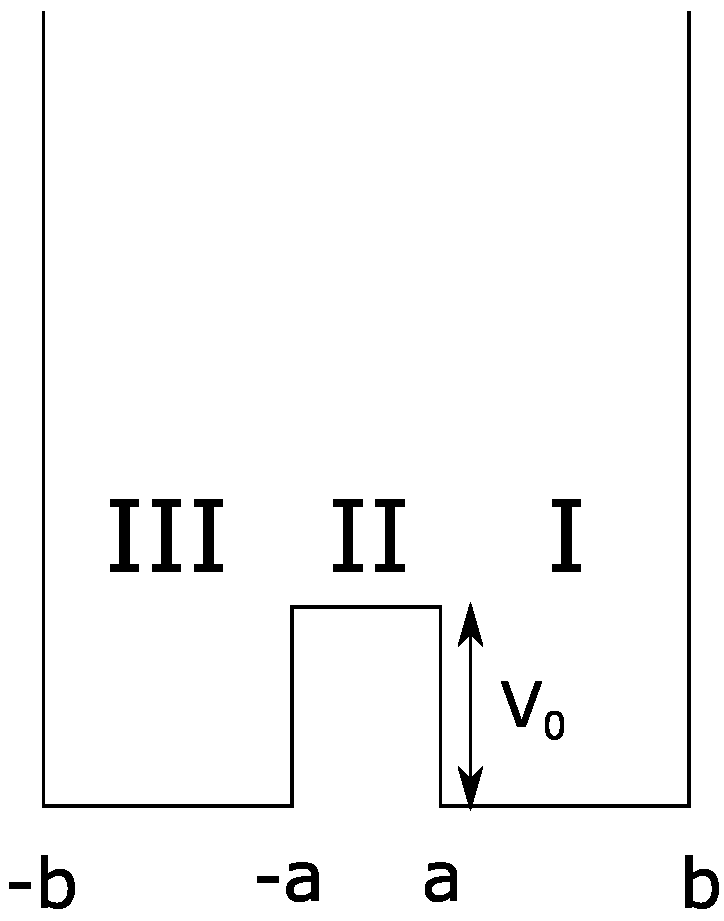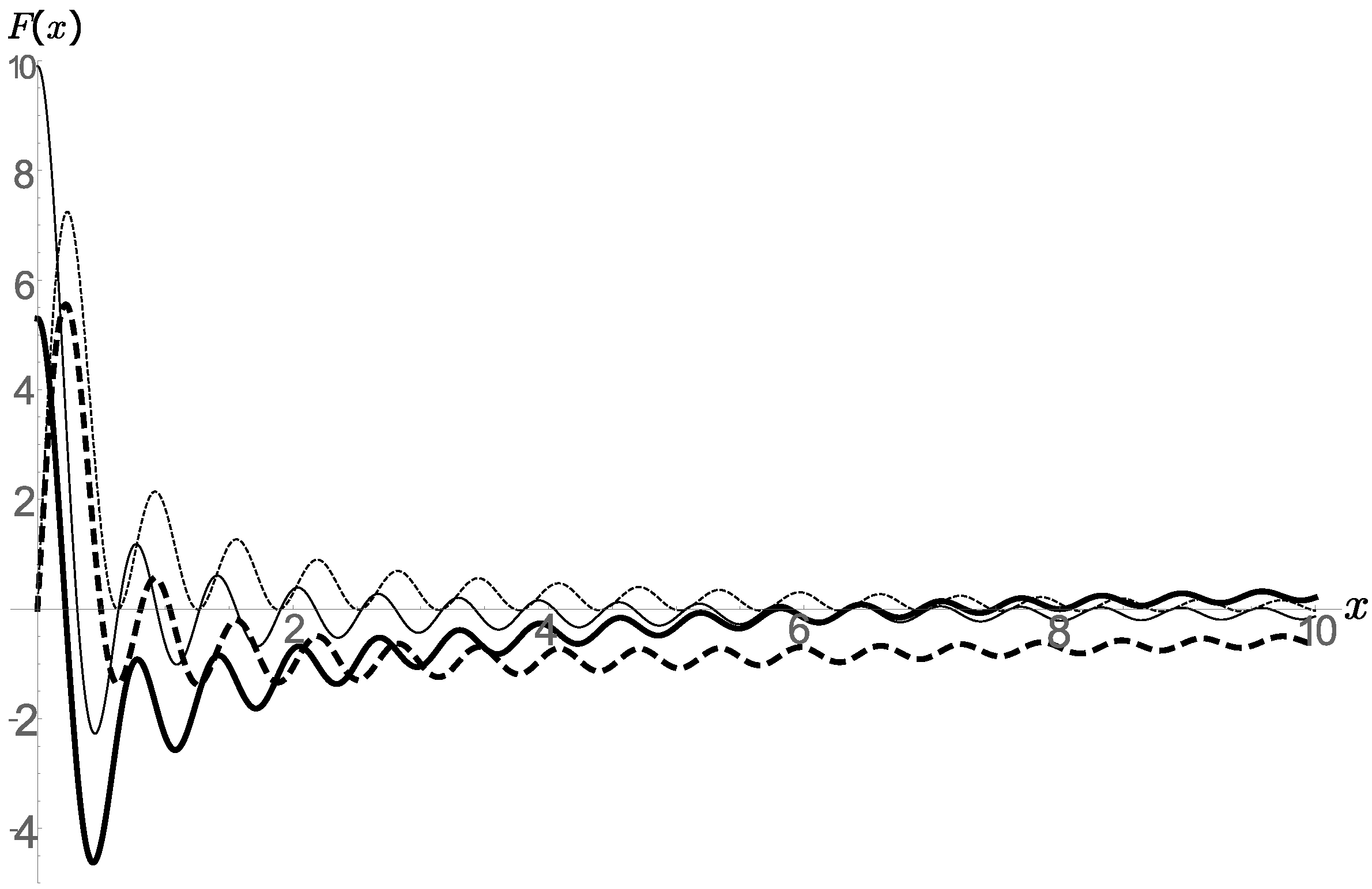Inspecting Non-Perturbative Contributions to the Entanglement Entropy via Wavefunctions
Abstract
1. Introduction
2. Toy Example of a Two-Particle System
2.1. Generalization to Multiple Minima
2.2. Generalization to Many Particles with Two Minima
2.2.1. Particles on a Ring: Periodic Boundary Condition
2.2.2. Particles on a Line: Without the Periodic Boundary Condition
3. Tunneling and Entanglement Entropy
3.1. Setup
4. Free Bosons
4.1. Appropriate Bogoliubov Transformation
4.2. A Discussion
5. Discussions
Acknowledgments
Author Contributions
Conflicts of Interest
Appendix A
Appendix A.1. Multi-Particle
Appendix A.2. Double Well Tunneling Revisited
- (1)
- We will first assume is very small, so the well is very thin, and we set .
- (2)
- Next, set and , where is a very small number.
- (3)
- Finally, we will carry out all the calculations by taking this double limit and such that the ratio of remains finite.
Appendix A.3. False Vacuum Tunneling
References
- Levin, M.; Wen, X.G. Detecting Topological Order in a Ground State Wave Function. Phys. Rev. Lett. 2006, 96, 110405. [Google Scholar] [CrossRef] [PubMed]
- Kitaev, A.; Preskill, J. Topological entanglement entropy. Phys. Rev. Lett. 2006, 96, 110404. [Google Scholar] [CrossRef] [PubMed]
- Chen, X.; Gu, Z.-C.; Liu, Z.-X.; Wen, X.-G. Symmetry protected topological orders in interacting bosonic systems. arXiv, 2013; arXiv:1301.0861. [Google Scholar]
- Wen, X.G. Classifying gauge anomalies through symmetry-protected trivial orders and classifying gravitational anomalies through topological orders. Phys. Rev. D 2013, 88, 045013. [Google Scholar] [CrossRef]
- Kong, L.; Wen, X.G. Braided fusion categories, gravitational anomalies, and the mathematical framework for topological orders in any dimensions. arXiv, 2014; arXiv:1405.5858. [Google Scholar]
- Wang, J.C.; Gu, Z.-C.; Wen, X.G. Field theory representation of gauge-gravity symmetry-protected topological invariants, group cohomology and beyond. Phys. Rev. Lett. 2015, 114, 031601. [Google Scholar] [CrossRef] [PubMed]
- Ryu, S.; Takayanagi, T. Holographic derivation of entanglement entropy from AdS/CFT. Phys. Rev. Lett. 2006, 96, 181602. [Google Scholar] [CrossRef] [PubMed]
- Ryu, S.; Takayanagi, T. Aspects of Holographic Entanglement Entropy. J. High Energy Phys. 2006, 2006, 045. [Google Scholar] [CrossRef]
- Swingle, B. Entanglement Renormalization and Holography. Phys. Rev. D 2012, 86, 065007. [Google Scholar] [CrossRef]
- Pastawski, F.; Yoshida, B.; Harlow, D.; Preskill, J. Holographic quantum error-correcting codes: Toy models for the bulk/boundary correspondence. J. High Energy Phys. 2015, 2015, 149. [Google Scholar] [CrossRef]
- Hayden, P.; Nezami, S.; Qi, X.L.; Thomas, N.; Walter, M.; Yang, Z. Holographic duality from random tensor networks. J. High Energy Phys. 2016, 2016, 9. [Google Scholar] [CrossRef]
- Bhattacharyya, A.; Gao, Z.S.; Hung, L.Y.; Liu, S.N. Exploring the Tensor Networks/AdS Correspondence. J. High Energy Phys. 2016, 2016, 86. [Google Scholar] [CrossRef]
- Czech, B.; Lamprou, L.; McCandlish, S.; Sully, J. Tensor Networks from Kinematic Space. J. High Energy Phys. 2016, 2016, 100. [Google Scholar] [CrossRef]
- Vidal, G.; Latorre, J.I.; Rico, E.; Kitaev, A. Entanglement in quantum critical phenomena. Phys. Rev. Lett. 2003, 90, 227902. [Google Scholar] [CrossRef] [PubMed]
- Latorre, J.I.; Rico, E.; Vidal, G. Ground state entanglement in quantum spin chains. Quant. Inf. Comput. 2004, 4, 48–92. [Google Scholar]
- Srednicki, M. Entropy and area. Phys. Rev. Lett. 1993, 71, 666–669. [Google Scholar] [CrossRef] [PubMed]
- Peschel, I. On the entanglement entropy for a XY spin chain. J. Stat. Mech. 2004, 2004, P12005. [Google Scholar] [CrossRef]
- Jin, B.-Q.; Korepin, V.E. Quantum Spin Chain, Toeplitz Determinants and Fisher-Hartwig Conjecture. J. Stat. Phys. 2004, 116, 79–95. [Google Scholar] [CrossRef]
- Its, A.R.; Jin, B.Q.; Korepin, V.E. Entanglement in XY Spin Chain. J. Phys. A Math. Gen. 2005, 38, 2975–2990. [Google Scholar] [CrossRef]
- Plenio, M.B.; Eisert, J.; Dreissig, J.; Cramer, M. Entropy, entanglement, and area: Analytical results for harmonic lattice systems. Phys. Rev. Lett. 2005, 94, 060503. [Google Scholar] [CrossRef] [PubMed]
- Cramer, M.; Eisert, J.; Plenio, M.B.; Dreissig, J. An entanglement-area law for general bosonic harmonic lattice systems. Phys. Rev. A 2006, 73, 012309. [Google Scholar] [CrossRef]
- Das, S.; Shankaranarayanan, S. How robust is the entanglement entropy-area relation? Phys. Rev. D 2006, 73, 121701. [Google Scholar] [CrossRef]
- Wolf, M.M. Violation of the entropic area law for Fermions. Phys. Rev. Lett. 2006, 96, 010404. [Google Scholar] [CrossRef] [PubMed]
- Gioev, D.; Klich, I. Entanglement entropy of fermions in any dimension and the Widom conjecture. Phys. Rev. Lett. 2006, 96, 100503. [Google Scholar] [CrossRef] [PubMed]
- Barthel, T.; Chung, M.C.; Schollwock, U. Entanglement scaling in critical twodimensional fermionic and bosonic systems. Phys. Rev. A 2006, 74, 022329. [Google Scholar] [CrossRef]
- Li, W.; Ding, L.; Yu, R.; Roscilde, T.; Hass, S. Scaling behavior of entanglement in two- and three-dimensional free-fermions systems. Phys. Rev. B 2006, 74, 073103. [Google Scholar] [CrossRef]
- Orus, R. Entanglement and majorization in (1 + 1)-dimensional quantum systems. Phys. Rev. A 2005, 71, 052327. [Google Scholar] [CrossRef]
- Holzhey, C.; Larsen, F.; Wilczek, F. Geometric and renormalized entropy in conformal field theory. Nucl. Phys. B 1994, 424, 443–467. [Google Scholar] [CrossRef]
- Calabrese, P.; Cardy, J. Entanglement entropy and quantum field theory. J. Stat. Mech. 2004, 2004, P06002. [Google Scholar] [CrossRef]
- Calabrese, P.; Cardy, J. Entanglement entropy and quantum field theory: A non-technical introduction. Int. J. Quant. Inf. 2006, 04, 429–438. [Google Scholar] [CrossRef]
- Casini, H.; Fosco, C.D.; Huerta, M. Entanglement and alpha entropies for a massive Dirac field in two dimensions. J. Stat. Mech. 2005, 2005, P07007. [Google Scholar] [CrossRef]
- Casini, H.; Huerta, M. Entanglement and alpha entropies for a massive scalar field in two dimensions. J. Stat. Mech. 2005, 2005, P12012. [Google Scholar] [CrossRef]
- Metlitski, M.A.; Fuertes, C.A.; Sachdev, S. Entanglement entropy in the O(N) model. Phys. Rev. B 2009, 80, 115122. [Google Scholar] [CrossRef]
- Hertzberg, M.P.; Wilczek, F. Some Calculable Contributions to Entanglement Entropy. Phys. Rev. Lett. 2011, 106, 050404. [Google Scholar] [CrossRef] [PubMed]
- Hertzberg, M.P. Entanglement Entropy in Scalar Field Theory. J. Phys. A 2013, 46, 015402. [Google Scholar] [CrossRef]
- Mozaffar, M.R.M.; Mollabashi, A. On the Entanglement Between Interacting Scalar Field Theories. J. High Energy Phys. 2016, 2016, 15. [Google Scholar] [CrossRef]
- Mollabashi, A.; Shiba, N.; Takayanagi, T. Entanglement between Two Interacting CFTs and Generalized Holographic Entanglement Entropy. J. High Energy Phys. 2014, 2014, 185. [Google Scholar] [CrossRef]
- Hung, L.Y.; Myers, R.C.; Smolkin, M. Some Calculable Contributions to Holographic Entanglement Entropy. J. High Energy Phys. 2011, 2011, 39. [Google Scholar] [CrossRef]
- Li, H.; Haldane, F.D.M. Entanglement Spectrum as a Generalization of Entanglement Entropy: Identification of Topological Order in Non-Abelian Fractional Quantum Hall Effect States. Phys. Rev. Lett. 2008, 101, 010504. [Google Scholar] [CrossRef] [PubMed]
- Chamon, C.; Hamma, A.; Mucciolo, E.R. Emergent Irreversibility and Entanglement Spectrum Statistics. Phys. Rev. Lett. 2014, 112, 240501. [Google Scholar] [CrossRef] [PubMed]
- Coleman, S.R. The Fate of the False Vacuum. 1. Semiclassical Theory. Phys. Rev. D 1977, 16, 2929–2936. [Google Scholar] [CrossRef]
- Callan, C.G., Jr.; Coleman, S.R. The Fate of the False Vacuum. 2. First Quantum Corrections. Phys. Rev. D 1977, 16, 1762. [Google Scholar] [CrossRef]
- Coleman, S.R. The Uses of Instantons. In The Whys of Subnuclear Physics; Antonino, Zichichi, Ed.; The Subnuclear Series; Springer: Boston, MA, USA, 1979; pp. 805–941. [Google Scholar]
- Polyakov, A.M. Quark Confinement and Topology of Gauge Groups. Nucl. Phys. B 1977, 120, 429. [Google Scholar] [CrossRef]
- Callan, C.G., Jr.; Dashen, R.F.; Gross, D.J. Toward a Theory of the Strong Interactions. Phys. Rev. D 1978, 17, 2717. [Google Scholar] [CrossRef]
- Schwinger, J.S. Gauge Invariance and Mass. II. Phys. Rev. 1962, 128, 2425. [Google Scholar] [CrossRef]
- Rothe, K.D.; Swieca, J.A. Path Integral Representations for Tunneling Amplitudes in the Schwinger Model. Ann. Phys. 1979, 117, 382–392. [Google Scholar] [CrossRef]
- Iso, S.; Murayama, H. Hamiltonian Formulation of the Schwinger Model: Nonconfinement and Screening of the Charge. Prog. Theor. Phys. 1990, 84, 142. [Google Scholar] [CrossRef]
- Azakov, S. The Schwinger model on a circle: Relation between Path integral and Hamiltonian approaches. Int. J. Mod. Phys. A 2006, 21, 6593. [Google Scholar] [CrossRef]
- Berwanger, D.; Grädel, E. Entangelement—A Measure for the Complexity of Directed Graphs with Applications to Logic and Games. In Logic for Programming, Artificial Intelligence, and Reasoning; Springer: Berlin/Heidelberg, Germany, 2005; pp. 209–223. [Google Scholar]
- Donetti, L.; Hurtado, P.I.; Munoz, M.A. Entangled networks, synchronization and optimal network topology. Phys. Rev. Lett. 2005, 95, 188701. [Google Scholar] [CrossRef] [PubMed]
- De Beaudrap, N.; Giovannetti, V.; Severini, S.; Wilson, R. Interpreting the von Neumann entropy of graph Laplacians, and coentropic graphs. arXiv, 2013; arXiv:1304.7946. [Google Scholar]
- Valatin, J.G. Comments on the theory of superconductivity. Il Nuovo Cimento 1958, 7, 843–857. [Google Scholar] [CrossRef]
- Bogoliubov, N. On the theory of superfluidity. J. Phys. 1947, 11, 91–92. [Google Scholar]
- Fetter, A.; Walecka, J. Quantum Theory of Many-Particle Systems; Dover Publications: Mineola, NY, USA, 2003; ISBN 9780486428277. [Google Scholar]
- Kittel, C. Quantum Theory of Solids; Wiley: New York, NY, USA, 1987. [Google Scholar]
- Strutinsky, V.M. Shell effects in nuclear physics and deformation energies. Nucl. Phys. A 1967, 95, 420–442. [Google Scholar] [CrossRef]
- Svozil, K. Squeezed Fermion states. Phys. Rev. Lett. 1990, 65, 3341–3343. [Google Scholar] [CrossRef] [PubMed]
- Bhattacharyya, A.; Hung, L.Y.; Melby-Thompson, C.M. Instantons and Entanglement Entropy. arXiv, 2017; arXiv:1703.01611. [Google Scholar]
- Giamarchi, T. Quantum Physics in One Dimension; International Series of Monographs on Physics; Oxford University Press: Oxford, UK, 2004. [Google Scholar]
- Wikipedia: Spectral Graph theory. Available online: https://en.wikipedia.org/wiki/Spectral_graph_theory (accessed on 6 December 2017).
- Griffiths, D.J. Introduction to Quantum Mechanics; Pearson Education: London, UK, 2005. [Google Scholar]
- Coleman, S. Aspects of Symmetry; Cambridge University Press: Cambridge, UK, 1985. [Google Scholar]
- Calabrese, P.; Cardy, J. Quantum quenches in 1 + 1 dimensional conformal field theories. J. Stat. Mech. 2016, 1606, 064003. [Google Scholar] [CrossRef]
- Casini, H.; Huerta, M. Entanglement entropy in free quantum field theory. J. Phys. A 2009, 42, 504007. [Google Scholar] [CrossRef]
- Weinberg, S. The Quantum Theory of Fields, Volume 1: Foundations; Cambridge University Press: Cambridge, UK, 1995. [Google Scholar]
- Bianchi, E.; Hackl, L.; Yokomizo, N. Entanglement entropy of squeezed vacua on a lattice. Phys. Rev. D 2015, 92, 085045. [Google Scholar] [CrossRef]
- Hiroshima, T. Decoherence and Entanglement in Two-mode Squeezed Vacuum States. Phys. Rev. A 2001, 63, 022305. [Google Scholar] [CrossRef]




© 2017 by the authors. Licensee MDPI, Basel, Switzerland. This article is an open access article distributed under the terms and conditions of the Creative Commons Attribution (CC BY) license (http://creativecommons.org/licenses/by/4.0/).
Share and Cite
Bhattacharyya, A.; Hung, L.-Y.; Lau, P.H.C.; Liu, S.-N. Inspecting Non-Perturbative Contributions to the Entanglement Entropy via Wavefunctions. Entropy 2017, 19, 671. https://doi.org/10.3390/e19120671
Bhattacharyya A, Hung L-Y, Lau PHC, Liu S-N. Inspecting Non-Perturbative Contributions to the Entanglement Entropy via Wavefunctions. Entropy. 2017; 19(12):671. https://doi.org/10.3390/e19120671
Chicago/Turabian StyleBhattacharyya, Arpan, Ling-Yan Hung, Pak Hang Chris Lau, and Si-Nong Liu. 2017. "Inspecting Non-Perturbative Contributions to the Entanglement Entropy via Wavefunctions" Entropy 19, no. 12: 671. https://doi.org/10.3390/e19120671
APA StyleBhattacharyya, A., Hung, L.-Y., Lau, P. H. C., & Liu, S.-N. (2017). Inspecting Non-Perturbative Contributions to the Entanglement Entropy via Wavefunctions. Entropy, 19(12), 671. https://doi.org/10.3390/e19120671




